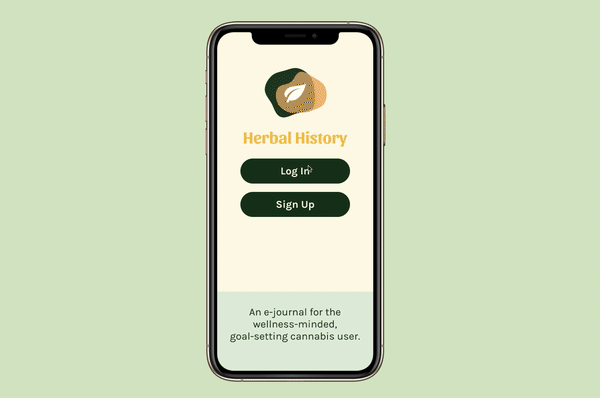
During my Human-Computer Interaction class in Spring 2021, a team of three others and I created an e-journal mobile app for users of medical cannabis to log their “sessions” in order to track how much their medication helps with their mood, illnesses, and more. The app also helps users keep track of their habits and favorite products. All in all, Herbal History helps users take charge of their own health and be more involved in their treatment.
Semester-long Group Project
Ideation, Research, Visual Design and Wireframes, Prototyping, some Front-End Development, Copy
React Native Mobile Application
Figma High-Fidelity Prototype; React Native App, Research Report
Medical marijuana is a recent development that is legal in around two thirds of US states. While people use cannabis legally, there are past stigmas and attitudes against users and the product itself. The shortage of research on the drug causes misinformation to spread and few resources available for users. The reason for a low amount of research on the drug is that the US Drug Enforcement Agency considers marijuana likely to be abused and lacking in medical value. Cannabis users use this drug for a variety of health reasons such as mood, pain, and seizures.
When it comes to the use of medical marijuana there is a lack of software available. This application will be made for users to track their usage of marijuana to record their experiences and understand their treatment. The app will also provide beneficial information to the patient and allow individual sessions to be recorded. Doctors suggest journaling to track the effects of various marijuana products in these categories. The main demographic for self-tracking are college students who use medical marijuana. There are not a lot of resources out there to track a patient’s use of cannabis. The journaling will allow users to better understand their medication and its potential benefits.
How can we create an e-journal app that allows medical cannabis users to intellectualize their own treatment journey? How do we incorporate the concept of the Quantified Self?
We performed contextual inquiries with a couple of medical cannabis users in order to understand their behaviors, habits, and practices, especially in the context of filling out an journal. The contextual inquiries consisted of background questions about their cannabis use, working together to determine what kinds of elements they would want in a cannabis e-journal, filling out an existing cannabis journal to observe their habits (made by Curaleaf), and follow-up questions about the journal.
We interviewed a few cannabis users about their cannabis habits (e.g. frequency, types of products), reasons for using cannabis, and their likeliness to use a cannabis journal. We asked about their past experiences with health tracking apps and the kinds of factors they would like to record if they were using a cannabis journal app.

I chose an earthy color palette with warm colors for contrast to match the herbal theme. The fonts I chose had a friendly, modern feel to them and I felt that they matched together well.



View the React Native App on GitHub here.
We performed a usability study on Herbal History by comparing it to one of the only similar existing apps, Releaf. We investigated whether there will be a measurable difference in time and ease to complete the tasks between the two interfaces by giving our test subjects a task to do on both (i.e. logging into an account and then filling out a journal entry in both). We also had them fill out some qualitative survey questions about their experience afterwards.
We performed a two-sample for means T-Test after studying all our subjects and we received these values:
t = 2.0325, df = 4, p-value = 0.1119
We failed to reject the null hypothesis, so we cannot definitively say that there is a significant difference between both applications. According to the qualitative survey afterwards, though, it does seem that our app is easier and more pleasurable to use compared to Releaf.